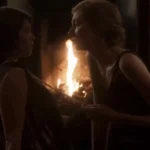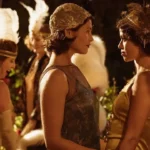Throughout history, lesbian poetry has played a vital role in giving voice to queer women’s experiences and emotions. Here are ten of the most influential and famous lesbian poems that have left an indelible mark on literature.

“Ode to Aphrodite” by Sappho
Shimmering-throned immortal Aphrodite,
Daughter of Zeus, Enchantress,
I implore thee,
Let not my soul be shattered with anguish.
This poem represents one of the earliest known expressions of same-sex love in Western literature. Sappho, writing from the island of Lesbos, was so influential that both the terms “lesbian” and “sapphic” derive from her name and homeland. The poem is famous for its direct appeal to Aphrodite, asking the goddess of love to help win the affections of a woman who has rejected the poet.
“Wild Nights – Wild Nights!” by Emily Dickinson
Wild Nights – Wild Nights!
Were I with thee
Wild Nights should be
Our luxury!
Futile – the winds –
To a Heart in port –
Done with the Compass –
Done with the Chart!

This passionate poem gained fame not only for its intensity but also for its connection to Susan Gilbert, Dickinson‘s sister-in-law. Many scholars believe their relationship went beyond friendship. The poem’s nautical metaphors for passionate love were radical for its time, especially coming from a woman writer in the 19th century.
“Power” by Audre Lorde
The difference between poetry and rhetoric
is being ready to kill
yourself instead of your children
Living in the hour of everyone's death.
As a Black lesbian feminist, Lorde wrote this poem during the Civil Rights movement. It became famous for addressing the intersections of race, gender, and sexuality. The poem speaks to the personal and political power of choosing one’s own truth in the face of oppression.
“Love Poem” by Adrienne Rich
Somewhere on the other side of this wide night
and the distance between us, I am thinking of you.
The room is turning slowly away from the moon.
Rich wrote this after coming out in the 1970s. The poem became an anthem for the lesbian feminist movement because it was one of the first times a major American poet openly wrote about lesbian love. Rich’s decision to publish such personal work helped pave the way for other lesbian writers.
“Diving into the Wreck” by Adrienne Rich
First having read the book of myths,
and loaded the camera,
and checked the edge of the knife-blade,
I put on the body-armor of black rubber.
This poem became famous as a metaphor for discovering one’s true identity. Rich wrote it during her process of coming out, using diving as a metaphor for exploring one’s deeper self. It won the National Book Award and is considered one of the most important feminist poems of the 20th century.
Related:
“Her Kind” by Anne Sexton
I have gone out, a possessed witch,
haunting the black air, braver at night;
dreaming evil, I have done my hitch
over the plain houses, light by light.
This poem became famous for its use of the “witch” as a metaphor for women who deviate from societal norms. Written during a time when lesbianism was taboo, Sexton’s poem challenged traditional female roles. The night-flying witch became a powerful symbol of lesbian identity and rebellion. The poem was later embraced by the feminist movement and lesbian rights activists.
“Poem About My Rights” by June Jordan
Even tonight and I need to take a walk and clear
my head about this poem about why I can't
go out without changing my clothes my shoes
my body posture my gender identity.
As a Black lesbian poet, Jordan’s work addresses the intersection of race, gender, and sexuality. This poem gained recognition for its raw honesty about existing as a marginalized person in multiple ways. It became a cornerstone text in women’s studies and LGBTQ+ literature courses, speaking to both personal and political struggles.
“The Woman Thing” by Judy Grahn
The woman thing
is to be invisible.
The woman thing
is to love without return.
Written around the time of the Stonewall riots, this poem captured the experience of lesbian invisibility in mainstream society. Its simple yet powerful language made it a rallying cry during the gay liberation movement. Grahn’s work influenced future generations of lesbian poets and helped establish lesbian-feminist poetry as a distinct literary tradition.
“Venus as a Boy” by Carol Ann Duffy
All the silver marks she'd made on his body
turned to gold when the sun shone.
His body was her lost country,
discovered, conquered, mapped.
As Britain’s first openly gay Poet Laureate, Duffy’s work revolutionized how lesbian desire could be expressed in mainstream poetry. This poem is celebrated for its bold gender play and reimagining of traditional love poetry. It represents the more confident, open expression of lesbian identity that emerged in the 1990s.
“The Forest of My Female Ancestors” by Gertrude Stein
In the midst of them all
with their noise and their talk
and their death and their walks
and their tender and brusque attacks.
Stein’s experimental writing style and open relationship with Alice B. Toklas made her a pioneer of lesbian literature. This poem is famous for its innovative language and exploration of female lineage and lesbian identity. Her Paris salon became a haven for modernist artists and writers, and her work influenced both literary modernism and lesbian cultural expression.
These poems represent different eras and styles but share common themes of love, identity, struggle, and empowerment. They have inspired generations of writers and readers, helping to shape our understanding of lesbian literature and experience.
For more sapphic literary content, check out our collection of Best Lesbian Romance Novels and Modern Lesbian Poetry Recommendations.
Further Reading
- 5 Best Movies Like Kiss Me (Kyss Mig)
- Vita & Virginia (2018) – A Lesbian Love Story of Literary Legends and Desire
- Colette (2018) – Lesbian Biopic of Literary Rebellion and Desire in Belle Époque Paris
- Summerland (2020) – Lesbian Romance and Wartime Drama on the Kent Coast
- Tell It to the Bees (2018) – Lesbian Period Romance Set in 1950s Scotland














